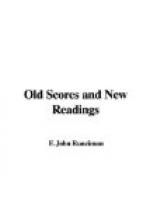did not spin his web precisely thus; but we shall
presently see that his method was derived from the
declamatory method. Much remained to be done first.
Lawes got rid of the old scholasticism, now effete.
But he never seemed quite sure that his expression
would come off. It is hard at this day to listen
to his music as Milton must have listened to it; but
having done my best, I am compelled to own that I
find some of his songs without meaning or comeliness,
and must assume either that our ancestors of this period
had a sense which has been lost, or that the music
played a less important part compared with the poem
than has been generally supposed. Lawes lost
rhythm, both as an element in beauty and a factor
in expression. Moreover, his harmonic resources
were sadly limited, for the old device of letting
crossing parts clash in sweet discords that resolved
into as sweet or sweeter concords was denied him.
What would be called nowadays the new harmony, the
new rhythm and the new forms were developed during
the Civil War and the Puritan reign. The Puritans,
loving music but detesting it in their churches, forced
it into purely secular channels; and we cannot say
the result was bad, for the result was Purcell.
John Jenkins and a host of smaller men developed instrumental
music, and, though the forms they used were thrown
aside when Charles II. arrived, the power of handling
the instruments remained as a legacy to Charles’s
men. Charles drove the secular movement faster
ahead by banning the old ecclesiastical music (which,
it appears, gave him “the blues"), and by compelling
his young composers to write livelier strains for
the church, that is, church music which was in reality
nothing but secular music. He sent Pelham Humphries
to Paris, and when Humphries came back “an absolute
Monsieur” (who does not remember that ever-green
entry in the Diary?) he brought with him all that
could possibly have been learnt from Lulli. He
died at twenty-seven, having been Purcell’s master;
and though Purcell’s imagination was richer,
deeper, more strenuous in the ebb and flow of its
tides, one might fancy that the two men had but one
spirit, which went on growing and fetching forth the
fruits of the spirit, while young Humphries’
body decayed by the side of his younger wife’s
in the Thames-sodden vaults of Westminster Abbey.
IV.
A complete list of Purcell’s compositions appears somewhat formidable at a first glance, but when one comes to examine it carefully the solidity seems somewhat to melt out of it. The long string of church pieces is made up of anthems, many of them far from long. The forty odd “operas” are not operas at all, but sets of incidental pieces and songs for plays, and some of the sets are very short. Thus Dryden talks of Purcell setting “my three songs,” and there are only half a dozen “curtain-tunes,” i.e. entr’actes. Many of the harpsichord pieces are of tiny proportions. The sonatas of




